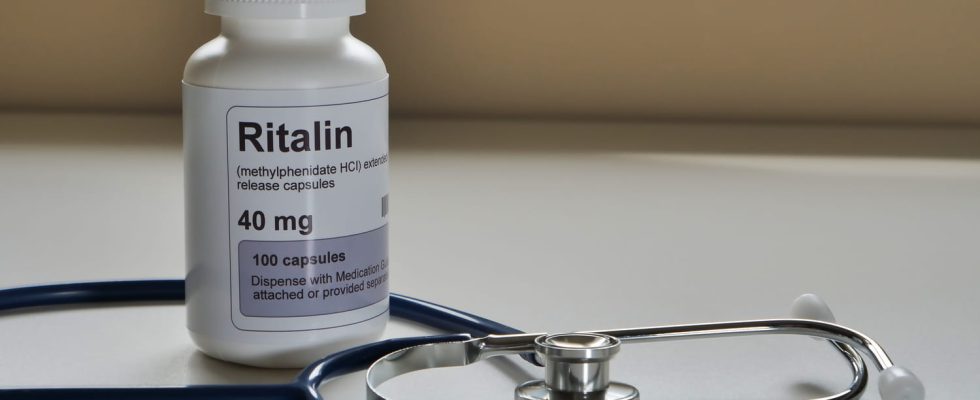Ritalin® is mainly indicated for the treatment of Attention Deficit Hyperactivity Disorder (ADHD). Responsible for numerous adverse effects, it is one of the drugs considered to be over-prescribed in young people aged 6 to 17.
In his report “When the children are bad, how to help them? published on March 13, 2023, the High Council for Family, Childhood and Age (HCFEA) issued an alert on the worrying overconsumption of psychotropic drugs among 6-17 year olds. A real increase in the consumption of these drugs has been observed in the under-20s between 2014 and 2021: +155% for sleeping pills, +78% for psychostimulants, +63% for antidepressants and +49% for neuroleptics. In the class of psychostimulants, the consumption of Ritalin® (methylphenidate) is experiencing a significant increase : the number of patients taking it has more than doubled among young people aged 6 to 17 years. Official recommendations are not always respected with prescriptions for children under 6 years of age (4,390 children between 2010 and 2019) or relatively long treatment times. Efficacy and safety have not been evaluated on doses longer than 12 months. However, the duration of treatment in 6-year-old children was 5.5 years in 2011. In which cases is Ritalin® indicated? What are the dangers of this drug?
What is Ritalin?
It’s a medicine containing methylphenidate which is a psychostimulant. Methylphenidate has a structure similar to amphetamines, thus it stimulates the central nervous system by increasing the amounts of dopamine and norepinephrine. In FranceRitalin® is a drug that can be administered orally classified as a narcotic, which implies a prescription limited to 28 days on a secure prescription.
What are the methylphenidate-based medicines in France?
Why is Ritalin prescribed?
Ritalin® LP (extended release) is commonly prescribed in adults and children from 6 years old to treat Attention Deficit Hyperactivity Disorder (ADHD). Prescription in adults is established on condition that ADHD is associated with significant occupational and social repercussions. Ritalin® immediate release is prescribed for the management of ADHD in children only. It also has an indication in the treatment of narcolepsy in children and adults with or without cataplexy (sudden loss of muscle tone). In adults, such a prescription is justified if Modiodal®, the first-line treatment, is ineffective.
What are the indications for Ritalin in children?
Ritalin® is indicated for children aged 6 and over to treat:
- THE Attention Deficit Hyperactivity Disorder (ADHD)
- narcolepsy with or without cataplexy (sudden loss of muscle tone)
Regarding ADHD, Ritalin® is prescribed after failure of non-drug treatments. The first prescription must come from a medical specialist who makes the diagnosis and then assesses the severity and chronicity of the symptoms. This approach makes it possible to judge the relevance of the treatment before initiating it since not all children with ADHD are eligible for Ritalin®. The purpose of the drug is to stabilize the child’s behavioral problems which are characterized in particular by limited attention, difficulty concentrating, loss of control of emotions, impulsiveness and continuous agitation.
What are the side effects of Ritalin?
Ritalin® is responsible for many side effects. The most commonly reported side effects include neurological disorders (nervousness, headache, dizziness, drowsiness, depression, insomnia) and cardiovascular disorders (heart palpitations, increased pulse, hypertension arterial). At the start of treatment, digestive disorders are frequent (nausea, vomiting, diarrhoea, abdominal pain, dry mouth). Taking the medication while eating will help reduce them. Likewise, cough, nasopharyngitis, fever, joint pain can manifest. At a epileptic, methylphenidate may be associated with a lowering of the seizure threshold. A decrease in appetite is also observed. Moreover, prolonged treatment may induce failure to thrive in children, and adult weight loss. Several clinical assessments are carried out before starting the treatment and then renewed regularly, they concern:
- cardiovascular status : measurement of blood pressure and pulse every 6 months in children and every month in adults
- weight, height and appetite every 6 months in children, weight only in adults
- psychiatric state : possible identification of behavioral disorders, anxiety, agitation every 6 months
What signs or symptoms to look out for when taking Ritalin?
During treatment in children, theANSM recommends that the onset or worsening of:
- motor tics
- repeated, difficult to control contractions of certain parts of the body;
- verbal tics:
- repetition of sounds and words;
- aggressive or hostile behavior;
- restlessness, anxiety or nervous tension;
- lack of appetite or refusal to eat;
- hallucinations (seeing, hearing or feeling things that are not real) or illusions (distorted perceptions of real sensations);
- paranoid-type signs (mistrust, exaggerated susceptibility, false judgment, hasty interpretation);
- signs evoking depression (great sadness, despair, feeling of uselessness, guilt);
- mood swings or changes in mood (including symptoms consistent with physical and mental over-excitement)
It is also necessary to identify any signs of cardiovascular or cerebrovascular damage during treatment:
- palpitations, chest pain,
- unexplained fainting,
- difficulty breathing;
- severe headaches,
- numbness,
- weakness or paralysis of a limb,
- impaired coordination, vision, speech, language or memory.
Sources:
– Report of the High Council for the Family, Childhood and Age (HCFEA), “When children are in bad shape: how to help them?”, March 13, 2023
– Methylphenidate: data on use and job safety in France, ANSM, updated on April 7, 2021
– Public drug database, ANSM
